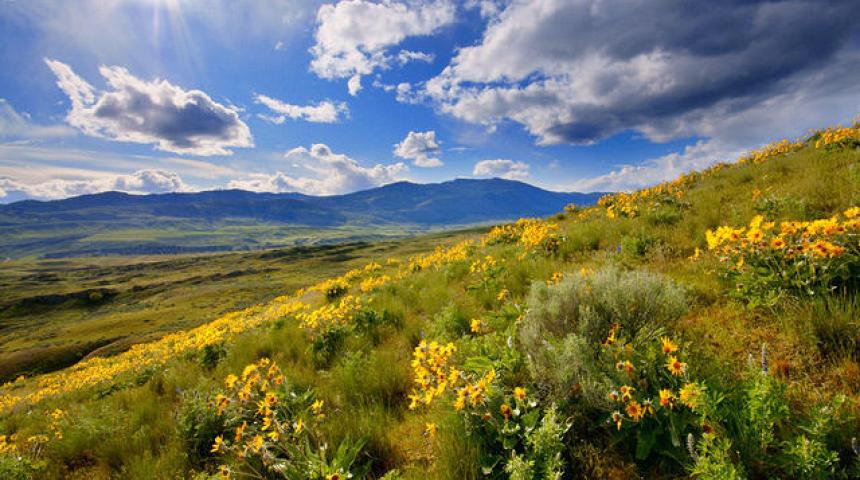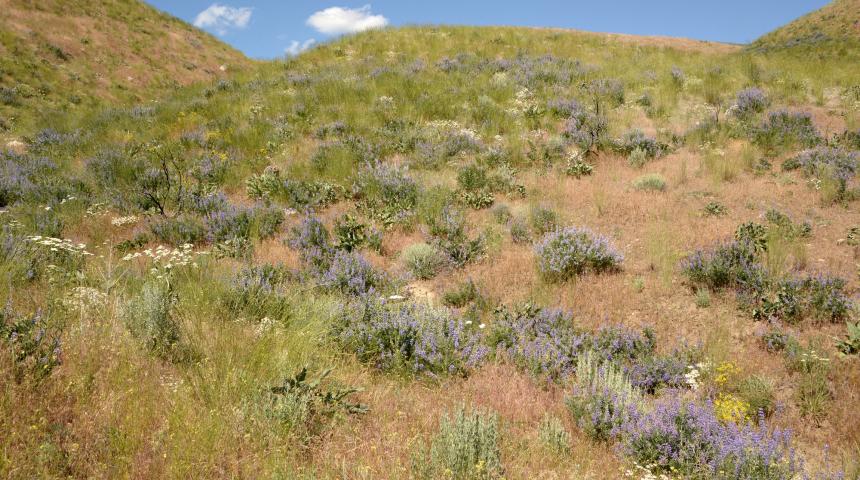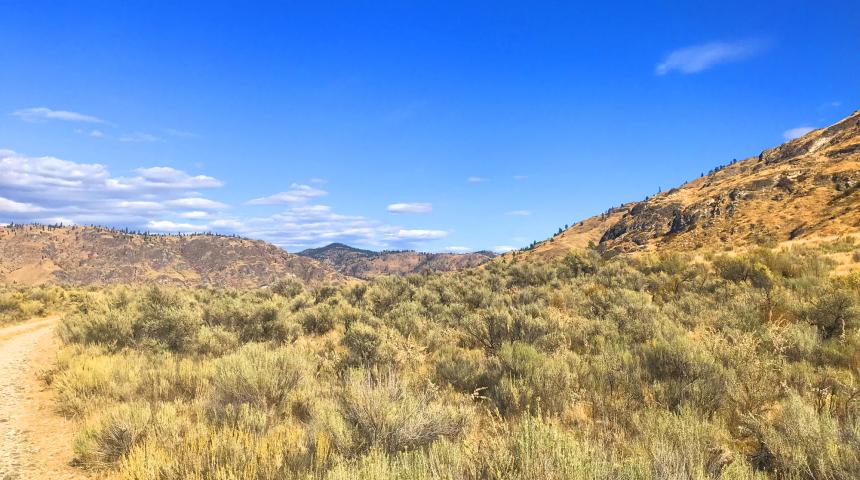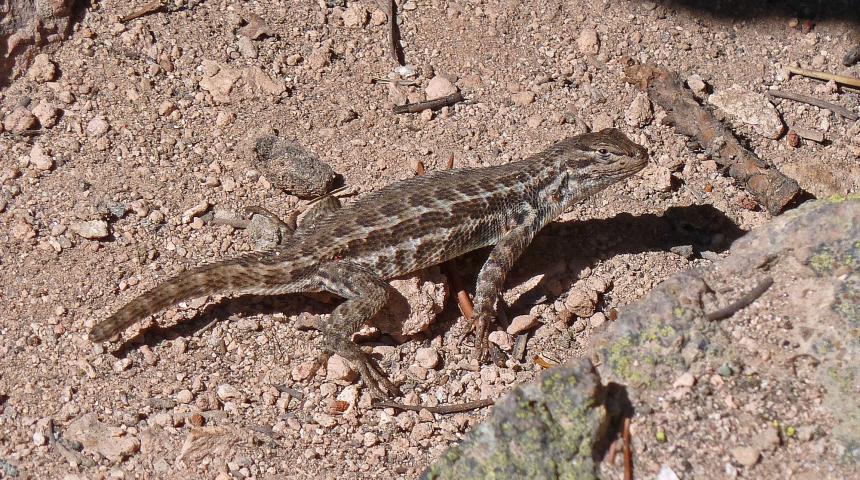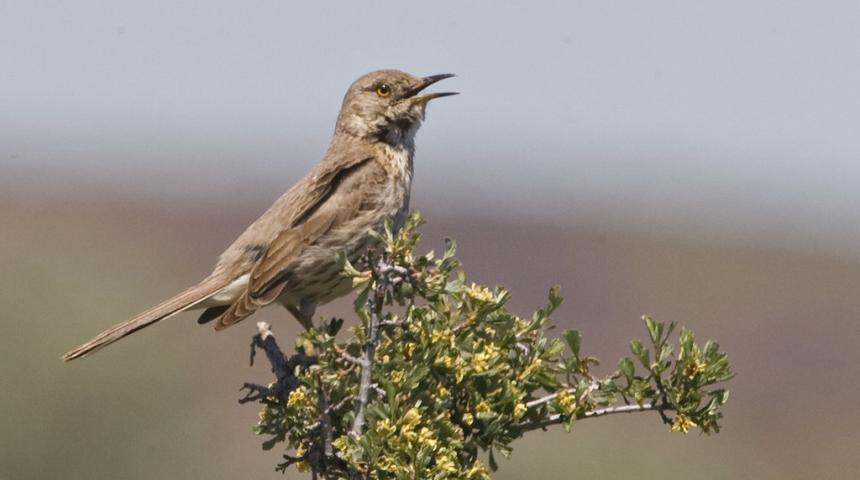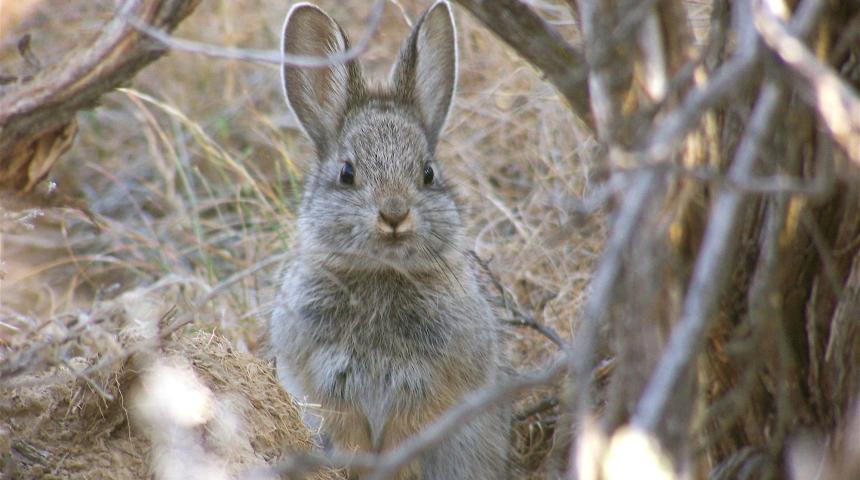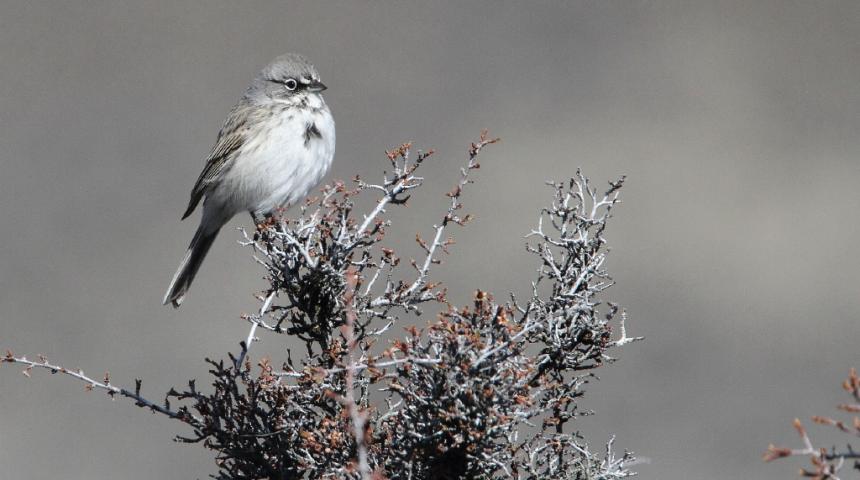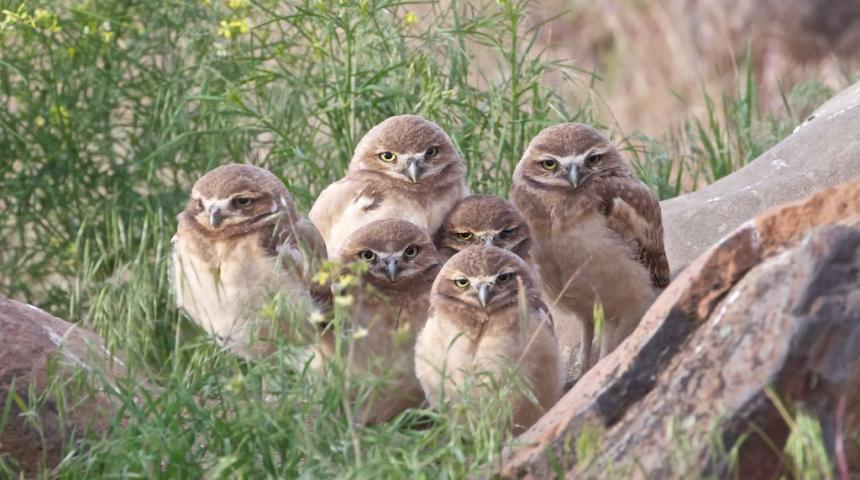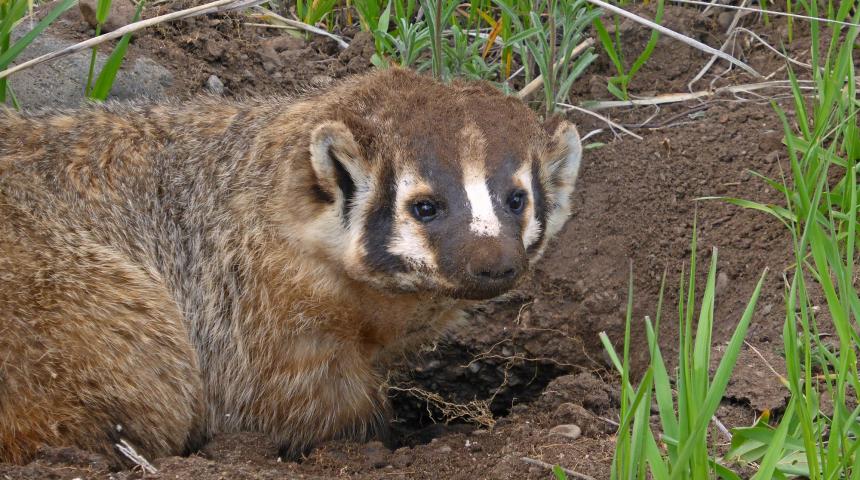The shrubsteppe is an arid ecosystem found in Eastern Washington and other western states. As one of Washington’s most diverse ecosystems, shrubsteppe provides habitat for species found nowhere else in the state, such as the Greater sage-grouse, sagebrush sparrow, and burrowing owl. With an estimated 80% of historic shrubsteppe lost or degraded to development and agriculture since the arrival of non-native settlers, protecting remaining shrubsteppe habitats is more important than ever.
Here, at the northern extent of the great “Sagebrush Sea” that once sprawled across much of the American West, growing collaboration between agencies, Native American tribes, conservation organizations, local landowners, and other partners seeks to preserve and restore shrubsteppe ecosystems while supporting cultural and economic values.
Despite impacts from severe wildfires and habitat fragmentation, recovery programs are underway for species such as the Greater sage-grouse, pygmy rabbit, sharp-tailed grouse, and pronghorn antelope, while efforts including the Washington Shrubsteppe Resiliency and Restoration Initiative (WSRRI), the Arid Lands Initiative, and Conservation Reserve Program foster constructive partnership for the future of Washington’s shrubsteppe.
- Take a virtual tour of the shrubsteppe (English)
- Haga un tour virtual de la estapa arbustiva (Español)
This Land is Part of Us: A short film produced by the Washington Department of Fish and Wildlife and Conservation Northwest. For wildlife lovers, hunters and anglers, Indigenous peoples, farmers and ranchers, outdoor recreationists and so many others, this land is no desert devoid of life, this land is part of us.
Description and range
Physical description
Shrubsteppe landscapes are dominated by rolling, grassy plains or “steppe,” with an overstory of sagebrush and other woody shrubs. On the ground, a fragile community of microscopic organisms form the cryptobiotic crust, which locks in moisture and helps prevent erosion. Various habitat features such as streams, wetlands, rocky talus slopes, and canyons support a variety of plants and animals uniquely adapted to the harsh and sensitive shrubsteppe ecosystem.
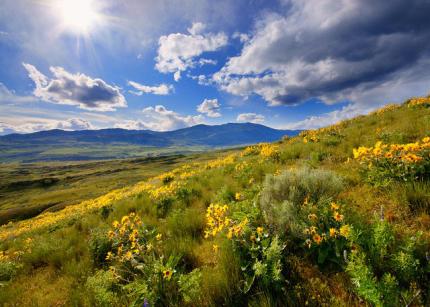
While Wyoming big sagebrush is the most widespread shrub in this ecosystem, other common shrubs include antelope bitterbrush, three-tip sagebrush, and stiff sagebrush. Common grasses include Idaho fescue, bluebunch wheatgrass, Sandberg bluegrass, Thurber's needlegrass, and needle-and-thread. Some shrubsteppe areas have a layer of algae, moss, or lichens which are part of the cryptobiotic crust. In areas with greater precipitation or on soils with higher moisture-holding capacity, shrubsteppe can also support a dense layer of flowering plants. Common and iconic groups of plants in the shrubsteppe include balsamroot, buckwheats, and lupines.
Of the 10.4 million acres of shrubsteppe that existed in Eastern Washington before European settlers arrived in the mid-19th century, only 20% remains. Many areas with deep-soil shrubsteppe (supporting Wyoming big sagebrush) were the first to be converted to agriculture. In addition, non-native grasses such as cheatgrass often dominate existing shrubsteppe, which eliminates most of the native shrub cover through altered fire cycles. Non-native grasses also provide little nutritional value for wildlife and are much more prone to burning. Although fire is a natural part of the shrubsteppe ecosystem, the presence of invasive grasses increases the frequency and intensity of wildfires, contributing to the continued decline of shrubsteppe habitat health.
Geographic range
Shrubsteppe landscapes extend from south-central British Columbia into Eastern Washington, Oregon, and California, through Idaho, Nevada, and Utah, and into western Wyoming and Colorado.
In Washington, shrubsteppe habitats are throughout the Columbia Plateau and into the surrounding higher elevations regions.
Species
Over 200 species of birds, 30 species of mammals, and numerous species of reptiles, amphibians, and insects live in and depend on Washington’s shrubsteppe. Look for mule deer, western fence lizards, burrowing owls, and northern Pacific rattlesnakes hiding amongst the sagebrush and bluebunch wheatgrass, which is the official state grass of Washington.
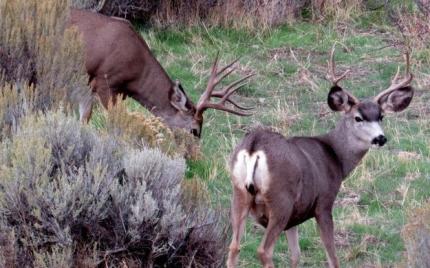
Since remaining shrubsteppe habitat is often fragmented due to development, species that depend on large, intact shrubsteppe habitat, such as the sage thrasher and sagebrush sparrow, are disproportionally affected. Although sensitive species may still use small patches of shrubsteppe, these fragmented areas usually offer less effective breeding habitat and are more susceptible to invasive weeds.
Shrubsteppe-dependent wildlife species
Although many shrubsteppe-dependent species are on the decline, this ecosystem continues to support a rich array of species, including elk, deer, bighorn sheep, bats, rabbits, rodents, frogs, snakes, lizards, and birds. Streams running through otherwise arid shrubsteppe can support species not typically thought of as living in arid climates such as porcupines, beavers, and songbirds.
Species of Greatest Conservation Need
Species of Greatest Conservation Need (PDF) include species that are state listed as sensitive, threatened, or endangered, or federal listed as threatened or endangered, as well as additional species thought to need conservation attention. These species of greatest conservation need are the basis for the State Wildlife Action Plan, which is an effort to protect rare species while keeping common species common.
The plan links species of greatest conservation need to the specific habitats they depend on. To not only survive but thrive, these species require quality habitats.
The following list features Species of Greatest Conservation Need that depend on shrubsteppe habitats.
Amphibians
Birds
- Burrowing owl
- Columbian sharp-tailed grouse*
- Ferruginous hawk*
- Greater sage-grouse*
- Sage thrasher
- Sagebrush sparrow
Mammals
Reptiles
- Common sharp-tailed snake
- Desert striped whipsnake
- Northern desert nightsnake
- Northern sagebrush lizard
- Pygmy short-horned lizard
- Ring-necked snake
- Side-blotched lizard
* Indicates "at-risk" species, meaning the animal is state listed as sensitive, threatened, or endangered, or is federal listed as threatened or endangered.
At-risk wildlife
Some species such as the Greater sage-grouse require large areas of undisturbed shrubsteppe to survive, as they rely on big sagebrush for cover and as a year-round food source and are highly sensitive to human disturbance, particularly during the breeding season. The federally-endangered pygmy rabbit is another species that depends on the sagebrush and undisturbed deep soil of shrubsteppe landscapes.
"At-risk" species include animals that are listed as sensitive, threatened, or endangered at the state or federal level.
Greater sage-grouse (Centrocercus urophasianus)
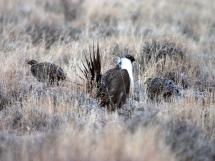
Governmental agencies and nongovernmental organizations are attempting to restore populations of greater sage-grouse with the aid of land acquisition, habitat improvement, conservation programs, and translocations. Between 2004 and 2016, WDFW, Yakima Training Center, Yakama Nation, and others collaborated to translocate this species from other states (Nevada, Oregon, Idaho, and Wyoming) to augment existing populations in Washington.
Did you know?
- During the mating season, males inflate yellow throat sacs to make popping sounds to attract females.
- Traditional lek (mating) sites may be used for years.
- Sage-grouse have a specialized stomach that can digest sagebrush, their main food.
Learn more about the greater sage-grouse.
Pygmy rabbit (Brachylagus idahoensis)
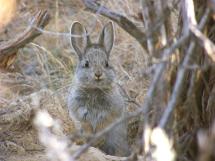
Major recovery efforts continue for the pygmy rabbit in Washington. In 2001, with as few as 16 pygmy rabbits known to exist in Washington, the WDFW and the U.S. Fish and Wildlife Service (USFWS) initiated a captive breeding program with the intent of reintroducing rabbits to the wild, but none of the pygmy rabbits from the first release in 2007 survived beyond the first year.
Since 2011, thousands of pygmy rabbits have been released into the wild on Sagebrush Flat Wildlife Area in Douglas County and on The Nature Conservancy Preserve in the Beezley Hills in Grant County as a result of collaborative recovery efforts between WDFW, USFWS, the Oregon Zoo, Washington State University, other state wildlife agencies, Northwest Trek, The Nature Conservancy in Washington, and Conservation Northwest.
Did you know?
- Pygmy rabbits make a whistle sound to warn others of predators.
- Rather than jumping like other rabbits, they scuttle close to the ground.
- They are one of two rabbit species that dig their own burrow.
Learn more about pygmy rabbits.
Northern leopard frog (Rana pipiens)
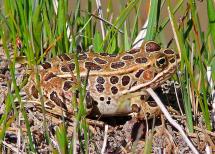
This frog is endangered in Washington. Only one known population remains -- in Grant County -- with limited information about population status and trends. Efforts are underway to determine the feasibility of translocations of these frogs to their former range.
Northern leopard frogs are semi-aquatic, requiring aquatic and terrestrial habitats. They are typically underwater (aquatic) during winter and on land (terrestrial) during the summer. The frogs require deep, well-oxygenated water that does not freeze solid for hibernation. These frogs are challenged by non-native vegetation and encroaching, native wetland vegetation that reduce the amount of exposed shoreline where they breed and forage. Northern leopard frogs may be preyed upon by many species throughout their life, but the most common are mustelids (weasel family carnivores), bullfrogs, and fish.
Did you know?
- The northern leopard frog is the only frog in Washington with round or oval dark spots arranged in irregular rows on its topside.
- Historically, this species was observed in seven Eastern Washington counties but is now only detected in one (Grant County).
- These frogs move across land, but little is known about their terrestrial movements in Washington.
Learn more about the northern leopard frog.
Ferruginous hawk (Buteo regalis)
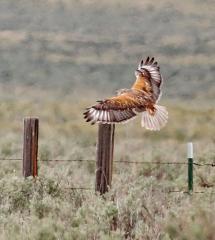
The population size of ferruginous hawks in Washington is low. This species is impacted by the loss and fragmentation of shrubsteppe and grasslands from agriculture and residential development and associated declines in distribution and abundance of its primary prey, jackrabbits and ground squirrels. Washington State is on the northwestern edge of the species' breeding range. In 2002, only 20% of historical ferruginous hawk nesting territories in Washington were occupied, with many vacant for years.
Did you know?
- The ferruginous hawk is the largest hawk in North America with an average 4.5-foot wing span.
- The word 'ferruginous' means rust-colored, and refers to the reddish color commonly seen on their back and legs.
- Ferruginous hawks and rough-legged hawks are the only North American hawks to have feathered legs all the way down to their toes.
Learn more about ferruginous hawks.
Columbian sharp-tailed grouse (Tympanuchus phasianellus columbianus)
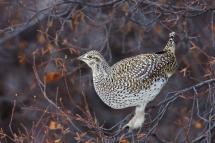
The population size of Columbian sharp-tailed grouse in Washington is low. Shortages of nesting, brood rearing, and wintering habitats are important factors limiting population recovery. Maintaining the species in Washington will require restoring habitat and increasing populations. The Columbian sharp-tailed grouse were the most abundant and important game bird in Eastern Washington during the 1800s. The current distribution of Columbian sharp-tailed grouse covers only about 2.8% of their historical range in Washington.
Did you know?
- In the spring, males gather on leks (traditional mating grounds) to dance and attract a mate. Males also inflate their purplish air sacs on the side of their neck to court females.
- Sharp-tailed grouse grow fleshy projections on their toes called pectinae that distribute the bird's weight as it walks across snow fields or other uneven terrain.
- In winter, these birds sometimes build tunnels in the snow for protection and to keep warm.
Places to explore
Washington’s wildlife areas provide habitat for fish and wildlife as well as land for outdoor recreation. Each year, hundreds of thousands of people visit these areas to hunt, camp, hike, fish, and enjoy other outdoor activities. These activities support local economies and contribute to Washington’s wildlife-related recreation industry.
WDFW owns or manages nearly a million acres of land on 33 wildlife areas across the state. In addition to wildlife areas, WDFW also owns or manages hundreds of water access areas that provide boating access to lakes, rivers, and marine areas.
All visitors to WDFW lands need to display a current Discover Pass or WDFW Vehicle Access Pass. Annual and daily Discover Passes are available online at fishhunt.dfw.wa.gov or at license vendors across the state. Vehicle Access Passes are free with the purchase of most Washington hunting or fishing licenses.
WDFW Wildlife Areas
- George Creek Wildlife Area Unit
The George Creek Unit is comprised of steep rocky canyons with riparian habitat in the canyon bottoms. George Creek forms the largest sub-basin within the Asotin Creek watershed, but this creek, along with its tributaries Pintler and Rockpile creeks, has no surface flow for the majority of the lower reaches.
- Quincy Lakes Wildlife Area Unit
The Quincy Lakes Unit has been shaped over time by lava flows, glacial floodwaters, erosion, and seepage from irrigation water. Visitors to this unit will experience towering 800-foot basalt cliffs, isolated mesas, stair stepped benches, box canyons, and potholes. Several of the potholes are filled with water that has seeped from the irrigation of the Quincy Basin farmlands upslope, adding important diversity to the unit's fish and wildlife habitat.
- Cowiche Wildlife Area Unit
The Cowiche Unit is an excellent example of intact shrubsteppe plant community attracting a variety of shrub steppe obligate birds. Birders and nature lovers can see many bird species and beautiful spring wildflowers throughout the area. Elk and mule deer can be found year-round. This unit is walk-in and horseback access ONLY.
- Whiskey Dick Wildlife Area Unit
The Whiskey Dick Unit offers steep, rocky slopes and rolling ridges and canyons, most of which are covered by shrubsteppe habitat. The Wild Horse Wind Farm, owned and managed by Puget Sound Energy is adjacent to the boundary of the Whiskey Dick Unit, and spans from Quilomene Ridge Road south to Vantage Highway.
- Revere Wildlife Area Unit
The Revere Wildlife Area consists of Palouse grassland/shrubsteppe/scabland terrain with seeps and springs in the Rock Creek drainage, supporting a rich array of wildlife species. The area is popular for hunting, mostly mule deer, upland bird, and coyote, and some people fish the creek. This is also a good area for viewing spring wildflowers and shrubsteppe obligate songbirds.
- Central Ferry Canyon Wildlife Area Unit
The Central Ferry Canyon Unit offers extensive shrubsteppe habitat for mule deer, sharp-tailed grouse, dusky grouse, white-tailed jackrabbit, sage thrasher, Brewer's sparrows, ravens, and other wildlife. Due to its northern aspect and elevation gain (more than 1,500 feet), the unit also supports a mixed forest habitat type including aspen, birch, Ponderosa pine and Douglas-fir. Hunter registration is required on this unit.
Other places to visit
- Columbia Basin National Wildlife Refuge
Enjoy listening to bird songs by day and coyote choruses by night. Dramatic cliffs and rimrock sit side-by-side with lakes, potholes, and marshes.
- Hanford Reach National Monument
The Hanford Reach National Monument is a place of sweeping vistas and stark beauty. Wildlife abounds in this harsh landscape, so keep an eye out for mule deer, coyotes, bald eagles, great blue herons, and white pelicans.
- Bureau of Land Management (BLM) Yakima River Canyon
The Yakima River Canyon offers excellent wildlife watching, fishing for Blue Ribbon trout, family-friendly rafting, and camping. The canyon’s crevices and cliffs make a perfect home for the densest concentration of nesting hawks, eagles, and falcons in the state.
- The Nature Conservancy Moses Coulee and Beezly Hills Preserve
Totaling more than 30,000 acres, the Moses Coulee and Beezly Hills preserves offer incredible geological scenery such as Ice Age floods-carved coulees, pothole lakes, haystack boulders, waterfalls, and dunes.
- Cowiche Canyon Conservancy
The Cowiche Canyon Conservancy owns and manages over 5,000 acres of land and provides more than 30 miles of trails for outdoor recreation.
Conservation
Shrubsteppe is identified as a “Priority habitat” under the Priority Habitat and Species Program. Priority habitats are habitat types or elements with unique or significant value to a diversity of species.
A priority habitat may consist of:
- A unique vegetation type such as shrubsteppe or a dominant plant species such as juniper savanna;
- A described successional stage such as old-growth forest; or
- A specific habitat feature such as cliffs.
WDFW management tools
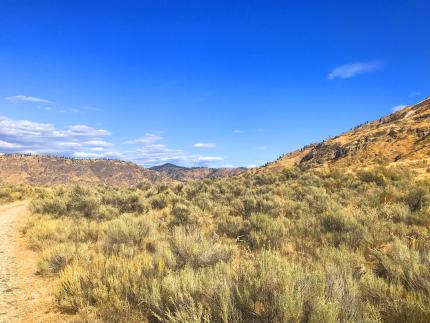
The Washington Shrubsteppe Restoration and Resiliency Initiative (WSRRI) seeks to address wildlife habitat protection and restoration challenges while also supporting working lands and communities in the face of wildland fire across Washington's shrubsteppe habitat. Wildland fire preparedness, response, and recovery are important components of this effort. The WSRRI long-term strategy provides management guidance for the next 30 years and includes five key elements focused on community engagement, habitat protection, habitat restoration, species management, and fire management.
The Priority Habitat and Species Program is the Department's primary means of transferring fish and wildlife information from our resource experts to local governments, landowners, and others who use it to protect habitat. This information is used primarily by cities and counties to implement and update land use plans and development regulations under the Growth Management Act and Shoreline Management Act.
In the Department’s State Wildlife Action Plan “Habitats of Greatest Conservation Need (PDF)” chapter, shrubsteppe includes these ecological systems of concern: the Columbia Plateau Low Sagebrush Steppe, Inter-Mountain Basins Big Sagebrush Steppe, and Inter-Mountain Basins Semi-Desert Shrubsteppe.
The State Wildlife Action Plan is part of a nationwide effort by all 50 states and five U.S. territories to develop conservation action plans for fish, wildlife, and their natural habitats—identifying opportunities for species’ recovery before they are imperiled and more limited. A habitat of greatest conservation need is defined as an ecological system and community types that are essential to the conservation of Species of Greatest Conservation Need in Washington.
Conservation threats and actions needed
As in other types of ecosystems, effects of climate change such as shifts in precipitation, drought, and wildfires may affect shrubsteppe plant composition, density, and distribution. Higher levels of rainfall increase plant growth and diversity, while drought negatively affects seedling survival in sagebrush systems and reduces shrub cover. These factors can also exacerbate increased climate change-induced alterations to frequency and intensity of wildfires, which can negatively affect native plants and loss of native shrub cover and expansion of annual grasses.
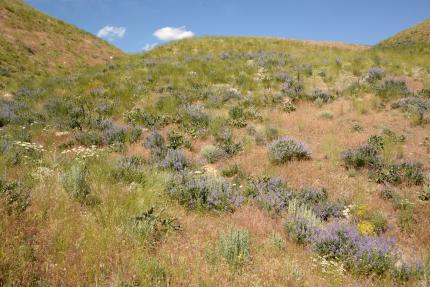
Major threats to shrubsteppe habitat
- Conversion of shrubsteppe to cropland
- Wind and solar power
- Residential development
- Soil disturbance
- Invasive plants
- Increased fire frequency and intensity
- Excessive grazing
- Roads and transmission lines
Actions needed to maintain quality habitat
- Manage land to maintain the appropriate wildfire frequency and prevent catastrophic fires
- Control invasive species, especially cheatgrass
- Restore habitat and native species
- Restore damaged shrubsteppe habitats by replanting site adapted native shrubsteppe plant species
- Ensure grazing practices are consistent with the needs of fish and wildlife
Conservation efforts
WDFW strives to maintain and restore shrubsteppe to benefit all species. When you visit a WDFW wildlife area, you may see staff and volunteers planting native plants or removing invasive weeds.
In December 2020, WDFW worked with a Washington Conservation Corps crew from the Department of Ecology to pick millions of tiny sagebrush seeds by hand. These seeds were planted to speed up the regrowth process on wildlife areas impacted by the Pearl Hill fire in September 2020. Watch the video below to learn more.
Fire management
WDFW biologists are working with various stakeholder groups to work on solutions that may lead to managing fire cycles to have a smaller footprint and less intensity, which in turn should lead to conservation of shrubsteppe habitat.
Get involved
Volunteer
- Register as a WDFW volunteer to help with activities that benefit fish, wildlife, and habitat.
Get involved in your community
- Provide input to your local government about development in shrubsteppe and its impacts to fish and wildlife species.
- For example: Take advantage of the public engagement opportunities afforded through Washington State’s land use planning frameworks, including the Growth Management Act (GMA). All towns, cities, and counties are required to protect critical areas, which include fish and wildlife habitat conservation areas (FWHCAs).
- If you are an agricultural landowner, producer, or other agricultural operator, and your county participates in the Voluntary Stewardship Program (VSP), get involved with the county’s VSP Work Group.
- Engage with partners working as part of the Arid Lands Initiative which is tackling management, conservation, and restoration of shrubsteppe in Eastern Washington.
- Consider The Partners for Fish and Wildlife Program through U.S. Fish and Wildlife Service. This program provides free technical and financial assistance to landowners, managers, tribes, corporations, schools, and nonprofits interested in improving wildlife habitat on their land.
- Reach out to your local habitat biologist or private lands biologist (PDF) for ideas on how to conserve, protect, and restore shrubsteppe in your area.
Support public lands
- Buy a Discover Pass for yourself or as a gift– this parking pass provides access to recreation lands managed by WDFW, Washington State Parks, and Washington Department of Natural Resources; and purchasing the pass provides funding to those agencies.
- Recreate responsibly in the great outdoors, including following “Leave No Trace” principles.
Share your shrubsteppe experience
- Share your photos and observations of shrubsteppe wildlife species for us to help monitor wildlife populations and habitat.
Resources
WDFW publications and guides
- Explore Shrubsteppe (English brochure)
Brochure with information about recreation and conservation in shrubsteppe.
- Explora la estepa arbustiva (Spanish brochure)
Un folleto con informacion de la recreacion y conservacion en la estepa arbustiva.
- Shrubsteppe and Grassland Restoration Manual for the Columbia River Basin (2011)
This manual was prepared to help shrub-steppe and grassland restoration practitioners capitalize on the experiences of their predecessors and colleagues within the Columbia River Basin. It also identifies potential resources, and provides tools for documenting work and sharing information. This manual is intended to be a work in progress, and will be updated periodically as new information becomes available.
- Seedling Identification Guide for Columbia Basin Shrub-Steppe and Grassland Res…
The purpose of this guide is to help people identify native plants and potentially harmful weeds on shrub steppe and grassland restoration sites in the Columbia Basin.
- Management Recommendations for Washington’s Priority Habitats: Managing Shrub-s…
These management recommendations offer strategies for balancing community growth with the needs and requirements of wildlife that use healthy shrubsteppe. The intended audience is city and county governments, developers, landowners, conservation groups, and others planning for future homes and businesses. While this is not a regulatory publication, we encourage land managers who work in this field to consider the strategies we offer.
- Long-range Planning: Considering Shrub-steppe Landscape (2011)
This document provides guidance for making decisions that affect shrubsteppe from the perspective of a long-range planner.
- Site-specific Management: How to Avoid and Minimize Impacts of Development to S…
The first step in managing for development impacts in shrubsteppe is recognizing when shrub-steppe exists near the proposal. While this may seem obvious, many do not recognize shrub-steppe. To avoid this situation, communities can develop systems to flag project proposals at the earliest stages.
- Sagebrush Conservation Strategy - Challenges to Sagebrush Conservation
This publication is an overview and assessment of the challenges facing land managers and landowners in conserving sagebrush ecosystems. This strategy is intended to provide guidance so that the unparalleled collaborative efforts to conserve the iconic greater sage-grouse (Centrocercus urophasianus) by State and Federal agencies, Tribes, academia, nongovernmental organizations, and stakeholders can be expanded to the entire sagebrush biome to benefit the people and wildlife that depend on this ecosystem. This report is organized into 3 parts.
Educational materials
- Educational sagebrush trunk
The Sagebrush Ecosystem Trunk contains all the materials an educator needs to introduce this ecosystem. This trunk is filled with new curricula and activities to get youth excited about the habitat that is so vital to several western states.
- Rockie the burrowing owl
Introduce students or children to the wonders of the sagebrush ecosystem through Rockie's Sagebrush Adventures! This illustrated book follows a Burrowing Owl and her friends as they discover what life in the sagebrush is all about. You can download this book for free or order print copies.
- Sagebrush flashcards
Students can use these printable flashcards to learn about the shrubsteppe ecosystem and the plants and animals that live there.
- STEM education and work-based learning
Explore science, technology, engineering, and math (STEM) resources and activities for students to learn more about the shrubsteppe ecosystem.
Other resources
- Partnering to conserve sagebrush rangeland
Partners in the Sage focuses on key ingredients for conservation that benefit people, wildlife, and economies.
- Washington Native Plant Society - Plant assemblages of the shrubsteppe
From a fast-moving highway, shrubsteppe landscapes may appear uniform. However, they are composed of diverse plant assemblages that change with soil type, slope, aspect and geomorphic characteristics that influence soil-water relations and insolation.
- Audubon’s Sagebrush Ecosystem Initiative
This initiative brings together citizens, industry, government, and non-governmental organizations to find pragmatic solutions that balance the needs of people and birds.
- Arid Lands Initiative
The Arid Lands Initiative is composed of multiple private and public entities in Eastern Washington who benefit from coordinating ongoing actions with each other, to help each of them achieve their own goals and objectives.
